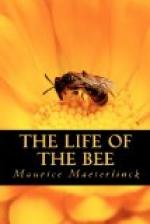It is generally admitted to-day that workers and queens, after the hatching of the egg, receive the same nourishment,—a kind of milk, very rich in nitrogen, that a special gland in the nurses’ head secretes. But after a few days the worker larvae are weaned, and put on a coarser diet of honey and pollen; whereas the future queen, until she be fully developed, is copiously fed on the precious milk known as “royal jelly.”
[68]
About a week has passed since the departure of the old queen. The royal nymphs asleep in the capsules are not all of the same age, for it is to the interest of the bees that the births should be nicely gradationed, and take place at regular intervals, in accordance with their possible desire for a second swarm, a third, or even a fourth. The workers have for some hours now been actively thinning the walls of the ripest cell, while the young queen, from within, has been simultaneously gnawing the rounded lid of her prison. And at last her head appears; she thrusts herself forward; and, with the help of the guardians who hasten eagerly to her, who brush her, caress her, and clean her, she extricates herself altogether and takes her first steps on the comb. At the moment of birth she too, like the workers, is trembling and pale, but after ten minutes or so her legs become stronger, and a strange restlessness seizes her; she feels that she is not alone, that her kingdom has yet to be conquered, that close by pretenders are hiding; and she eagerly paces the waxen walls in search of her rivals. But there intervene here the mysterious decisions and wisdom of instinct, of the spirit of the hive, or of the assembly of workers. The most surprising feature of all, as we watch these things happening before us in a hive of glass, is the entire absence of hesitation, of the slightest division of opinion. There is not a trace of discussion or discord. The atmosphere of the city is one of absolute unanimity, preordained, which reigns over all; and every one of the bees would appear to know in advance the thought of her sisters. And yet this moment is the gravest, the most vital, in their entire history. They have to choose between three or four courses whose results, in the distant future, will be totally different; which, too, the slightest accident may render disastrous. They have to reconcile the multiplication of species—which is their passion, or innate duty—with the preservation of the hive and its people. They will err at times; they will successively send forth three or four swarms, thereby completely denuding the mother-city; and these swarms, too feeble to organise, will succumb, it may be, at the approach of winter, caught unawares by this climate of ours, which is different far from their original climate, thatthe bees, notwithstanding all, have never forgotten. In such cases they suffer from what is known as “swarming fever;” a condition wherein life, as in ordinary fever, reacting too ardently on itself, passes its aim, completes the circle, and discovers only death.




